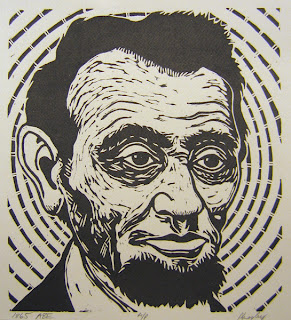The work below, entitled
Winston, is based on a 1940 photograph taken of Winston Churchill shortly after test firing a Tommy gun. The well-dressed politician, gingerly holding a weapon favored by gangsters and soldiers alike, instantly grabbed my attention; I felt that the weighty, paradoxical image would lend itself to a large-scale portrait.

When I am approached to do a commission I am generally hesitant, as they are usually of a subject matter that is personal to the client instead of the artist. When I was given the small, black-and-white reproduction photograph of this historical icon I was instantly intrigued. I have always been interested in the life of Winston Churchill, and this project would give me the opportunity to learn more about this pivotal man who was also a prolific painter.
The painting presented a great challenge, since dealing with such a well-known face is intimidating when trying to capture the likeness of the individual. When I work with portraits, I generally prefer to change the features of the face so that there is not an exact replica to the original, be it from photograph or from life. This project was made even more challenging by the grainy, out-of-focus image from which I was working. Because of the poor quality likeness, I researched other photographs of Churchill from different times in his life to create a composite portrait reflecting his image from the early 1940s.
“Happy are the painters, for they shall not be lonely. Light, color, peace and hope will keep them company to the end, or almost to the end, of the day.” (Winston Churchill)
Portrait based upon the
Horton photograph of Winston Churchill, collection of the Imperial War Museum, London.



























 Head with Wings is based on a Calvin Jackson Ambrotype taken of Lincoln on October 1, 1858 (two years before he won the Presidency). Lincoln, pre-beard, appears untested, reserved yet focused.
Head with Wings is based on a Calvin Jackson Ambrotype taken of Lincoln on October 1, 1858 (two years before he won the Presidency). Lincoln, pre-beard, appears untested, reserved yet focused. Cohiba Lincoln is based on a Alexander Gardner Silver Gelatin Print taken of Lincoln on November 8, 1863 (mid-way through the Civil War). Lincoln's face is showing wear from the war. The war-tested President faces the viewer in a confrontational composition.
Cohiba Lincoln is based on a Alexander Gardner Silver Gelatin Print taken of Lincoln on November 8, 1863 (mid-way through the Civil War). Lincoln's face is showing wear from the war. The war-tested President faces the viewer in a confrontational composition. 1865 Abe is based on an Alexander Gardner Silver Gelatin Print taken of Lincoln on February 5, 1865 (four days before the assassination of Lincoln). Lincoln's face seems to have aged several years per year of the war yet in this photograph he seems at ease and is smiling slightly.
1865 Abe is based on an Alexander Gardner Silver Gelatin Print taken of Lincoln on February 5, 1865 (four days before the assassination of Lincoln). Lincoln's face seems to have aged several years per year of the war yet in this photograph he seems at ease and is smiling slightly.


